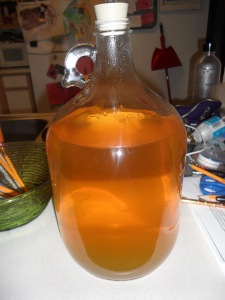Henry and I have been dabbling in home brewing for a year and a half now. We started with hard apple cider, which ended down the drain. Next was watermelon wine, which is still chilling out in the bottle, waiting to mature. After that was a lager, which has turned out the best of all of our recipes. Now we have moved on to garlic wine. The brew shop owner suggested it to us the very first time we went to see him, ask him questions, and buy his equipment. It sounded easy enough, and it was easy–but we didn’t think it through all the way, and neither did he give us any warnings.
So let this be your warning. Making this wine is only for the strong of will. You will smell things you wished you hadn’t. It will permeate your walls. Furniture. Everything. But you have to finish it–the damage is done. Roast, mince, boil, ferment. Do it. I’ll let you know how ours turned out next summer.
Equipment:
1. 2 gallon food safe bucket
2. 1 gallon carboy and airlock
3. Racking siphon
Recipe:
- 1.5 cups of orange juice
- 1 can of apple juice concentrate
- 3 T lemon juice
- 2 pounds of sugar
- 1 tsp Yeast nutrient
- 1 tsp Pectic enzyme
- 1 Packet Lalvin EC-1118 yeast
- 12 large heads of garlic
- 1/4 tsp tannin
Method:
First, prepare a yeast starter. Mix the juice, yeast nutrient, and pectic enzyme. Pitch the yeast.
Roast 6 of the heads of garlic for two hours at 350. When it cools, squeeze the cloves out.
Take the other 6 heads and peel them. Boil the raw garlic and roasted garlic together with 1/2 gallon of water for 45 minutes. Try to not die. The smell–oh, the eye burning smell! This boiling step will the longest 45 minutes of your entire life.
Strain the liquid into your food safe bucket, also known as your primary fermentation vessel. I used a combination of colander and cheese cloth. Add the apple concentrate, lemon juice, and tannin to the bucket. Stir. Add water until your volume equals one gallon.
Record the specific gravity. Or have your husband do it. It should be at least 1.074.
Oh, yeah. Don’t pitch the yeast into the other ingredients until it’s cooled to 90 degrees. Don’t want to fry the yeast.
Leave it in your food safe bucket for a week. Rack to a one gallon carboy, fitted with an airlock.
Rack it again after three weeks, and then after that, once or twice a month for six months. After you bottle it, it’ll be done a year from when you began the entire process.
